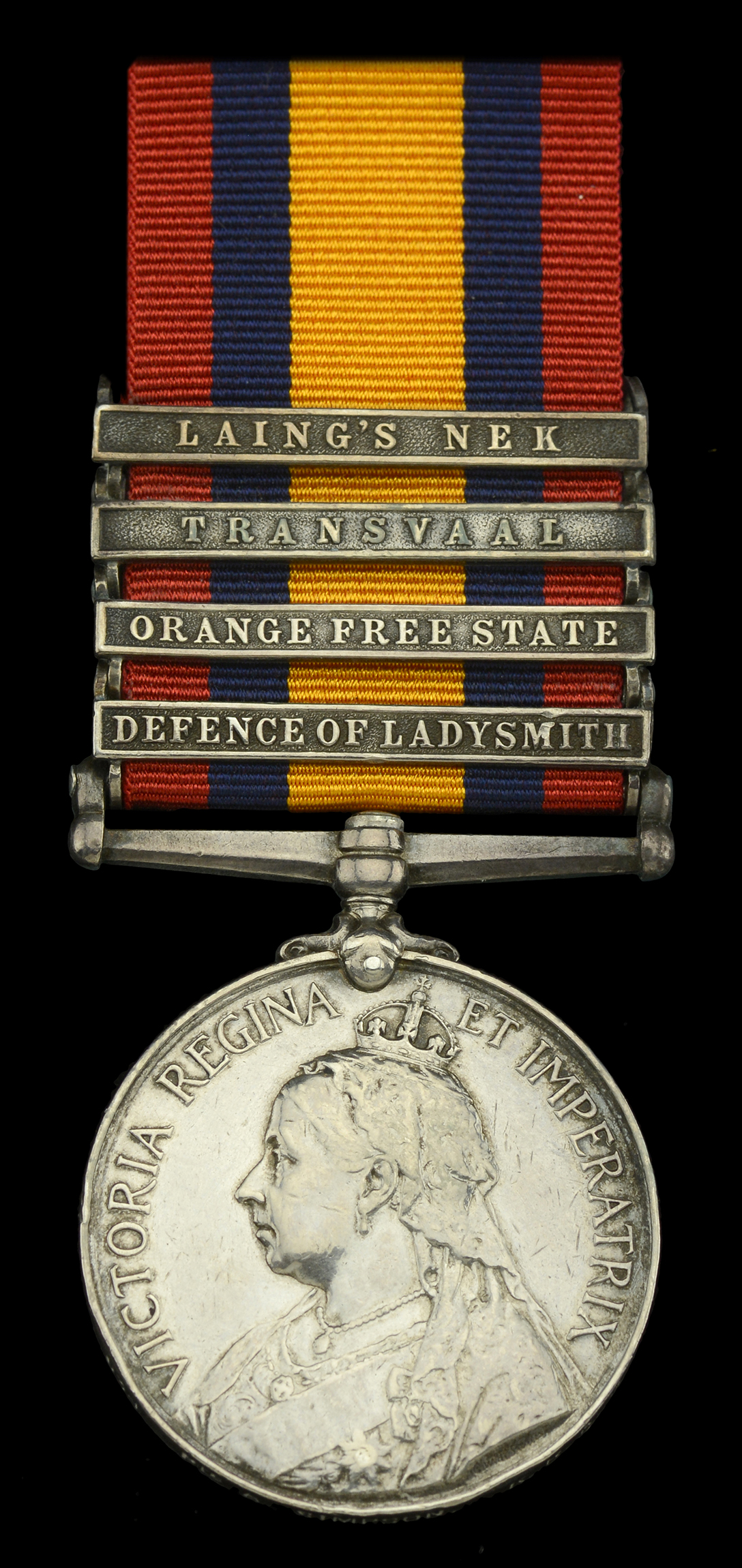The Queen’s South Africa Medal awarded to Private A. Simpson, King’s Royal Rifle Corps, later Lancashire Fusiliers, who was awarded the D.C.M. for his conspicuous gallantry near Gheluwe on 1 October 1918, when he went out alone over ground swept by machine gun fire to discover the exact position of a German machine gun ’pill-box’ post which was firing at his platoon: crawling round to its flank, he shot both sentries and on his return, stalked and shot an enemy sniper who had been ‘annoying his platoon’ Queen’s South Africa 1899-1902, 4 clasps, Defence of Ladysmith, Orange Free State, Transvaal, Laing’s Nek (634 Pte. A. Simpson, K.R.R.C.) edge bruising and contact marks, nearly very fine £200-£240 --- Provenance: Buckland Dix & Wood, May 1992 (when sold alongside the recipient’s other campaign medals and an unnamed DCM) D.C.M. London Gazette 12 March 1919 (citation published 2 December 1919):
‘On 1st October, 1918, near Gheluwe, he went out alone to reconnoitre the position of an enemy Machine Gun which was firing at his platoon. He worked forward over ground traversed by machine-gun fire, shot two sentries, thoroughly reconnoitred the enemy position, and on his way back shot a sniper who had been harassing his platoon. He showed great courage and initiative, and rendered excellent service.’ Arthur Simpson attested for the King’s Royal Rifle Corps, and served with the 2nd Battalion in South Africa during the Second Boer War, being attached to the Mounted Infantry Company. Whilst in South Africa, he transferred to the 4th Battalion King’s Royal Rifle Corps, and subsequently served, alongside 103 other men from the K.R.R.C., with the British Mounted Infantry as part of the Somaliland Field Force during the 1902-04 campaign against the ‘Mad Mullah’, where he was present at the engagement at Jidballi on 10 January 1904. Discharged to the Army Reserve, Simpson returned to his native Rochdale, but on the outbreak of war, he re-enlisted for service with the 1/6th Territorial (Rochdale) Battalion, Lancashire Fusiliers, with whom he sailed for Alexandria aboard the SS Saturnia on 9 December 1914. The battalion formed part of the Lancashire Fusilier Brigade, 42nd East Lancashire Division, and remained in Cairo until early May 1915 from where it sailed for Gallipoli, landing on 5 August 1915. Transferring to the 1st Battalion Lancashire Fusiliers, Simpson served in ‘A’ Company under the command of Captain C. Wedgwood, and was present at Gheluwe on 1 October 1918, when his company distinguished itself in penetrating strongly held enemy positions that were holding up the advance. The Regimental History provides the following description of the events leading up to the award of Simpson’s D.C.M.: ‘On the other flank, ‘A’ Company, passing through ‘B’ at dawn, succeeded in fighting its way forward about four hundred yards, with its flank just beyond the Gheluwe-Dadizeele road. Wedgwood was conspicuous for his skill, driving the enemy out of three strongholds and inflicting many casualties without any loss to his company, which in fact suffered only sixteen casualties throughout the four days of fighting. In his company was Private A. Simpson, who during this day’s operations went out alone to discover the exact position of a German machine gun which was firing at his platoon. He found the offending ‘pill-box’, crawled round to its flank, shot its two sentries, thoroughly reconnoitred the position and on his way back shot a sniper who had also been annoying his platoon’. Note: Simpson’s other campaign medals, comprising a King’s South Africa Medals with both date clasps; an Africa General Service Medal with clasps for Somaliland 1902-04 and Jidballi; and a 1914-15 Star trio; together with his Territorial Efficiency Medal, were sold in these rooms in December 2018.





